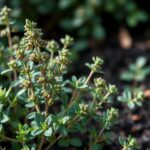Effective Strategies to Combat Leaf Spot Disease in Tomato Plants: A Complete Guide

Leaf spot disease is a common challenge faced by tomato growers, significantly impacting plant health and fruit yield. This fungal and bacterial condition manifests as unsightly spots on leaves, leading to early defoliation and reduced vigor. Understanding effective strategies to combat leaf spot disease is crucial for maintaining robust tomato plants. In this comprehensive guide, we will explore a variety of preventive measures, including proper cultural practices, organic and chemical treatments, and timely interventions to help you keep your tomato plants healthy. Whether you are a seasoned gardener or a novice, these strategies will equip you to fight against this pervasive threat.
Understanding Leaf Spot Disease in Tomato Plants
Leaf spot disease is a common fungal infection that affects tomato plants, leading to the development of dark, necrotic patches on leaves. These spots can severely disrupt the plant's ability to photosynthesize, which in turn affects overall growth and fruit production. The disease is primarily caused by various fungi, including Alternaria, Septoria, and Cladosporium, which thrive in conditions of high humidity and poor air circulation. Proper management strategies, such as crop rotation, selecting resistant varieties, and maintaining optimal watering practices, are essential to mitigate the effects of this disease and ensure healthy tomato crops.
Causes of Leaf Spot Disease
The primary causes of leaf spot disease in tomato plants are fungal pathogens, notably Alternaria solani, Septoria lycopersici, and Cladosporium fulvum. These fungi enter plant tissues through wounds or natural openings, particularly during periods of high moisture and warm temperatures. The spores are often spread via wind, rain, or contaminated gardening tools and equipment. Additionally, overcrowded planting can lead to increased humidity, favoring the development of leaf spots as well as other foliar diseases.
Symptoms of Leaf Spot Disease
The symptoms of leaf spot disease can vary depending on the specific pathogen, but generally include the appearance of small, dark brown or black spots on the leaves, which can expand and cause leaf tissue to die. As the disease progresses, affected leaves may yellow and fall off, leading to reduced photosynthetic capacity. In severe cases, entire plants can be defoliated, resulting in stunted growth and reduced fruit yield. Early identification of symptoms is crucial for effective management.
Management Strategies
Effective management strategies for leaf spot disease include crop rotation, which helps disrupt the life cycle of the pathogens, and the use of resistant tomato varieties that are less susceptible to the disease. Regularly pruning plants to improve airflow can reduce humidity levels around the foliage, making conditions less favorable for fungal growth. Moreover, applying fungicides at the first sign of symptoms can help control the spread of the disease. Additionally, practicing good sanitation by cleaning tools and removing infected plant debris can significantly limit disease transmission.
See also:
Preventive Measures
Implementing preventive measures is crucial in the fight against leaf spot disease in tomato plants. Growing plants in well-drained soil and ensuring adequate spacing between plants promotes airflow and minimizes humidity. Furthermore, timely irrigation practices that avoid overhead watering can help keep foliage dry and less susceptible to fungal infections. Incorporating organic matter into the soil can enhance plant health and resilience, while monitoring weather conditions and employing fungal-resistant varieties adds an extra layer of protection against disease outbreaks.
Impact on Tomato Yield
Leaf spot disease can have a significant impact on tomato yield, as it directly affects the plant's photosynthesis and nutrient uptake. Infected plants may produce fewer fruits, and the quality of the remaining fruits may decline due to reduced vigor and stress from defoliation. In severe cases, leaf loss can result in decreased plant size and overall yield, which can harm the profitability of tomato production. Understanding the relationship between disease management and yield can help growers optimize their practices to ensure maximum output.
| Fungus | Symptoms | Management |
|---|---|---|
| Alternaria solani | Dark leaf spots with concentric rings | Fungicides, crop rotation, resistant varieties |
| Septoria lycopersici | Water-soaked spots that turn brown | Good sanitation, improved air circulation |
| Cladosporium fulvum | Olive-green to black lesions on leaves | Pruning, avoid overhead irrigation |
Understanding the Causes and Symptoms of Leaf Spot Disease in Tomatoes
Leaf spot disease in tomato plants is primarily caused by various fungal and bacterial pathogens that thrive in warm, humid conditions. Understanding the symptoms, such as dark lesions on the leaves that may eventually cause them to yellow, wilt, or drop, is crucial for early identification and management of this disease. The leaf spots can vary in shape and size depending on the specific pathogen involved; hence, recognizing these symptoms will enable gardeners to implement effective disease control strategies. Regular monitoring and environmental management can significantly reduce the incidence of these pathogens and foster healthier plants.
Preventive Measures for Leaf Spot Disease
Implementing preventive measures is essential in controlling leaf spot disease in tomato plants. These may include ensuring proper air circulation around the plants, as crowded plants are more susceptible to disease. Additionally, practicing crop rotation and removing any plant debris after the harvest helps break the disease cycle. Applying a layer of mulch can also protect the plants from excessive moisture on the foliage, which is a conducive environment for disease development.
Organic Treatment Options
When it comes to organic treatment options, neem oil and copper-based fungicides are often recommended to effectively combat leaf spot disease. Neem oil not only acts as a fungicide, but it also has properties that deter various pests that may further weaken the plants. Copper fungicides can inhibit the growth of the pathogens responsible for leaf spots, promoting healthier foliage without the use of synthetic chemicals. Regular application as per the guidelines can enhance the resilience of your tomato plants.
See also:
Cultural Practices to Minimize Disease Impact
Incorporating certain cultural practices can significantly minimize the impact of leaf spot disease on tomato plants. Watering plants at the base instead of overhead reduces leaf wetness, thus decreasing the chances of fungal infection. Additionally, choosing resistant varieties of tomatoes can be a proactive approach. Proper fertilization is also crucial; a balanced nutrient regimen strengthens the plants, making them less susceptible to diseases.
Pest Control and Its Importance
Pests can often act as vectors for the pathogens causing leaf spot disease in tomatoes, making pest control a vital aspect of disease management. Regularly checking for common pests such as aphids and whiteflies is necessary, as their presence can exacerbate the spread of leaf spots. Implementing an integrated pest management strategy that includes biological controls and insecticidal soaps will not only help in keeping the pest population in check but will also contribute to the overall health of the tomato plants.
Monitoring and Regular Maintenance
Consistent monitoring and regular maintenance are crucial for early detection and management of leaf spot disease. Gardeners should routinely inspect their plants for any signs of leaf spots or overall distress, recording changes over time. Pruning affected leaves promptly and maintaining a clean growing environment through the removal of fallen leaves and other debris can reduce disease prevalence. Establishing a consistent maintenance schedule ensures that the plants remain vigorous and are less prone to infections.
Questions from Our Readers
What is leaf spot disease in tomato plants?
Leaf spot disease is a fungal or bacterial infection that affects tomato plants, characterized by the appearance of dark, round spots on the leaves. These spots can lead to leaf drop, reduced photosynthesis, and ultimately impact the overall health and yield of the plant. Proper identification and management are crucial to prevent the spread of the disease.
What are the common causes of leaf spot disease in tomatoes?
The common causes of leaf spot disease in tomatoes include high humidity, poor air circulation, and overhead watering. These conditions create a favorable environment for fungal spores to thrive and spread. Additionally, using infected seeds or plants can introduce pathogens to the garden, exacerbating the problem.
See also:
How can I prevent leaf spot disease in my tomato plants?
To prevent leaf spot disease, ensure good cultural practices such as providing sufficient space between plants, avoiding overhead watering, and using disease-resistant varieties. Maintaining proper soil health and practicing crop rotation can also help minimize the risk of infection by disrupting the lifecycle of harmful pathogens.
What treatments are available for leaf spot disease in tomato plants?
Available treatments for leaf spot disease include applying fungicides or bactericides specifically formulated for use on tomato plants. It's essential to follow the manufacturer's instructions for application. Additionally, removing and disposing of infected leaves can help reduce the spread of the disease, along with improving air circulation around the plants.

If you want to read more articles like Effective Strategies to Combat Leaf Spot Disease in Tomato Plants: A Complete Guide, we recommend you check out our Gardeners category.
Leave a Reply
Related Articles